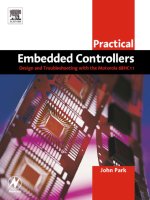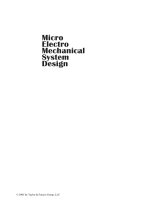Embedded system design by peter marwedel
Bạn đang xem bản rút gọn của tài liệu. Xem và tải ngay bản đầy đủ của tài liệu tại đây (3.54 MB, 250 trang )
EMBEDDED SYSTEM DESIGN
Embedded System Design
by
PETER MARWEDEL
University of Dortmund, Germany
A C.I.P. Catalogue record for this book is available from the Library of Congress.
ISBN-10
ISBN-13
ISBN-10
ISBN-13
1-4020-7690-8 (HB)
978-1-4020-7690-9 (HB)
0-387-29237-3 (PB)
978-0-387-29237-3 (PB)
Published by Springer,
P.O. Box 17, 3300 AA Dordrecht, The Netherlands.
www.springeronline.com
Printed on acid-free paper
All Rights Reserved
© 2006 Springer
No part of this work may be reproduced, stored in a retrieval system, or transmitted
in any form or by any means, electronic, mechanical, photocopying, microfilming, recording
or otherwise, without written permission from the Publisher, with the exception
of any material supplied specifically for the purpose of being entered
and executed on a computer system, for exclusive use by the purchaser of the work.
Printed in the Netherlands.
This book is dedicated
to my family.
Contents
Preface
xiii
Acknowledgments
xvii
1. INTRODUCTION
1
1.1
Terms and scope
1
1.2
Application areas
5
1.3
Growing importance of embedded systems
8
1.4
Structure of this book
9
2. SPECIFICATIONS
13
2.1
Requirements
13
2.2
Models of computation
16
2.3
StateCharts
18
2.3.1
Modeling of hierarchy
19
2.3.2
Timers
23
2.3.3
Edge labels and StateCharts semantics
24
2.3.4
Evaluation and extensions
26
2.4
General language characteristics
27
2.4.1
Synchronous and asynchronous languages
27
2.4.2
Process concepts
28
2.4.3
Synchronization and communication
28
vii
viii
EMBEDDED SYSTEM DESIGN
2.4.4
Specifying timing
29
2.4.5
Using non-standard I/O devices
30
2.5
SDL
30
2.6
Petri nets
36
2.6.1
Introduction
36
2.6.2
Condition/event nets
40
2.6.3
Place/transition nets
40
2.6.4
Predicate/transition nets
42
2.6.5
Evaluation
44
2.7
Message Sequence Charts
44
2.8
UML
45
2.9
Process networks
50
2.9.1
Task graphs
50
2.9.2
Asynchronous message passing
53
2.9.3
Synchronous message passing
55
2.10 Java
58
2.11 VHDL
59
2.11.1 Introduction
59
2.11.2 Entities and architectures
60
2.11.3 Multi-valued logic and IEEE 1164
62
2.11.4 VHDL processes and simulation semantics
69
2.12 SystemC
73
2.13 Verilog and SystemVerilog
75
2.14 SpecC
76
2.15 Additional languages
77
2.16 Levels of hardware modeling
79
2.17 Language comparison
82
2.18 Dependability requirements
83
Contents
ix
3. EMBEDDED SYSTEM HARDWARE
87
3.1
Introduction
87
3.2
Input
88
3.3
3.4
3.2.1
Sensors
88
3.2.2
Sample-and-hold circuits
90
3.2.3
A/D-converters
91
Communication
93
3.3.1
Requirements
94
3.3.2
Electrical robustness
95
3.3.3
Guaranteeing real-time behavior
96
3.3.4
Examples
97
Processing Units
98
3.4.1
Overview
98
3.4.2
Application-Specific Circuits (ASICs)
100
3.4.3
Processors
100
3.4.4
Reconfigurable Logic
115
3.5
Memories
118
3.6
Output
120
3.6.1
D/A-converters
121
3.6.2
Actuators
122
4. EMBEDDED OPERATING SYSTEMS,
MIDDLEWARE, AND SCHEDULING
125
4.1
Prediction of execution times
126
4.2
Scheduling in real-time systems
127
4.2.1
Classification of scheduling algorithms
128
4.2.2
Aperiodic scheduling
131
4.2.3
Periodic scheduling
135
4.2.4
Resource access protocols
140
4.3
Embedded operating systems
143
x
EMBEDDED SYSTEM DESIGN
4.4
4.3.1
General requirements
143
4.3.2
Real-time operating systems
144
Middleware
148
4.4.1
Real-time data bases
148
4.4.2
Access to remote objects
149
5. IMPLEMENTING EMBEDDED SYSTEMS:
HARDWARE/SOFTWARE CODESIGN
151
5.1
Task level concurrency management
153
5.2
High-level optimizations
157
5.2.1
Floating-point to fixed-point conversion
157
5.2.2
Simple loop transformations
159
5.2.3
Loop tiling/blocking
160
5.2.4
Loop splitting
163
5.2.5
Array folding
165
5.3
5.4
5.5
Hardware/software partitioning
167
5.3.1
Introduction
167
5.3.2
COOL
168
Compilers for embedded systems
177
5.4.1
Introduction
177
5.4.2
Energy-aware compilation
178
5.4.3
Compilation for digital signal processors
181
5.4.4
Compilation for multimedia processors
184
5.4.5
Compilation for VLIW processors
184
5.4.6
Compilation for network processors
185
5.4.7
Compiler generation, retargetable compilers
and design space exploration
185
Voltage Scaling and Power Management
186
5.5.1
Dynamic Voltage Scaling
186
5.5.2
Dynamic power management (DPM)
189
xi
Contents
5.6
Actual design flows and tools
190
5.6.1
SpecC methodology
190
5.6.2
IMEC tool flow
191
5.6.3
The COSYMA design flow
194
5.6.4
Ptolemy II
195
5.6.5
The OCTOPUS design flow
196
6. VALIDATION
199
6.1
Introduction
199
6.2
Simulation
200
6.3
Rapid Prototyping and Emulation
201
6.4
Test
201
6.4.1
Scope
201
6.4.2
Design for testability
202
6.4.3
Self-test programs
205
6.5
Fault simulation
206
6.6
Fault injection
207
6.7
Risk- and dependability analysis
207
6.8
Formal Verification
209
References
212
About the author
227
List of Figures
229
Index
236
Preface
Importance of embedded systems
Embedded systems can be defined as information processing systems embedded into enclosing products such as cars, telecommunication or fabrication
equipment. Such systems come with a large number of common characteristics, including real-time constraints, and dependability as well as efficiency
requirements. Embedded system technology is essential for providing ubiquitous information, one of the key goals of modern information technology
(IT).
Following the success of IT for office and workflow applications, embedded
systems are considered to be the most important application area of information technology during the coming years. Due to this expectation, the term
post-PC era was coined. This term denotes the fact that in the future, standardPCs will be a less dominant kind of hardware. Processors and software will be
used in much smaller systems and will in many cases even be invisible (this
led to the term the disappearing computer). It is obvious that many technical
products have to be technologically advanced to find customers’ interest. Cars,
cameras, TV sets, mobile phones etc. can hardly be sold any more unless they
come with smart software. The number of processors in embedded systems
already exceeds the number of processors in PCs, and this trend is expected
to continue. According to forecasts, the size of embedded software will also
increase at a large rate. Another kind of Moore’s law was predicted: For many
products in the area of consumer electronics the amount of code is doubling
every two years [Vaandrager, 1998].
This importance of embedded systems is so far not well reflected in many of the
current curricula. This book is intended as an aid for changing this situation. It
provides the material for a first course on embedded systems, but can also be
used by non-student readers.
xiii
xiv
EMBEDDED SYSTEM DESIGN
Audience for this book
This book intended for the following audience:
Computer science, computer engineering and electrical engineering students who would like to specialize in embedded systems. The book should
be appropriate for third year students who do have a basic knowledge of
computer hardware and software. This book is intended to pave the way
for more advanced topics that should be covered in a follow-up course.
Engineers who have so far worked on systems hardware and who have to
move more towards software of embedded systems. This book should provide enough background to understand the relevant technical publications.
Professors designing a new curriculum for embedded systems.
Curriculum integration of embedded systems
The book assumes a basic understanding in the following areas (see fig. 0.1):
electrical networks at the high-school level (e.g. Kirchhoff’s laws),
operational amplifiers (optional),
computer hardware, for example at the level of the introductory book by
J.L. Hennessy and D.A. Patterson [Hennessy and Patterson, 1995],
fundamental digital circuits such as gates and registers,
computer programming,
finite state machines,
fundamental mathematical concepts such as tuples, integrals, and linear
equations,
algorithms (graph algorithms and optimization algorithms such as branch
and bound),
the concept of NP-completeness.
A key goal of this book is to provide an overview of embedded system design
and to relate the most important topics in embedded system design to each
other. It should help to motivate students and teachers to look at more details.
While the book covers a number of topics in detail, others are covered only
briefly. These brief sections have been included in order to put a number of
xv
Preface
Figure 0.1.
Positioning of the topics of this book
related issues into perspective. Furthermore, this approach allows lecturers to
have appropriate links in the book for adding complementary material of their
choice. The book should be complemented by follow-up courses providing a
more specialized knowledge in some of the following areas:
digital signal processing,
robotics,
machine vision,
sensors and actors,
real-time systems, real-time operating systems, and scheduling,
control systems,
specification languages for embedded systems,
computer-aided design tools for application-specific hardware,
formal verification of hardware systems,
testing of hardware and software systems,
performance evaluation of computer systems,
low-power design techniques,
security and dependability of computer systems,
ubiquitous computing,
application areas such as telecom, automotive, medical equipment, and
smart homes,
xvi
EMBEDDED SYSTEM DESIGN
impact of embedded systems.
A course using this book should be complemented by an exiting lab, using, for
example, small robots, such as Lego MindstormT M or similar robots. Another
option is to let students gain some practical experience with StateCharts-based
tools.
Additional information related to the book can be obtained from the following web page:
/>This page includes links to slides, exercises, hints for running labs, references
to selected recent publications and error corrections. Readers who discover errors or who would like to make comments on how to improve the book should
send an e-mail to
Assignments could also use the information in complementary books [Ganssle,
1992], [Ball, 1996], [Ball, 1998], [Barr, 1999], [Ganssle, 2000], [Wolf, 2001],
[Buttazzo, 2002].
The use of names in this book without any reference to copyrights or trademark
rights does not imply that these names are not protected by these.
Please enjoy reading the book!
Dortmund (Germany), September 2003
P. Marwedel
Welcome to the current updated version of this book! The merger of Kluwer
and Springer publishers makes it possible to publish this version of the book
less than two years after the initial 2003 version. In the current version, all typos and errors found in the original version have been corrected. Moreover, all
Internet references have been checked and updated. Apart from these changes,
the content of the book has not been modified. A list of the errors corrected is
available at the web page listed above.
Please enjoy reading this updated book.
Dortmund (Germany), August 2005
P. Marwedel
Acknowledgments
My PhD students, in particular Lars Wehmeyer, did an excellent job in proofreading a preliminary version of this book. Also, the students attending my
course “Introduction to Embedded Systems” of the summer of 2003 (in particular Lars Bensmann) provided valuable help. In addition, the following colleagues and students gave comments or hints which were incorporated into this
book: W. M¨uller, F. Rammig (U. Paderborn), W. Rosenstiel (U. T¨ubingen), R.
D¨omer (UC Irvine), and W. Kluge (U. Kiel). Material from the following persons was used to prepare this book: G. C. Buttazzo, D. Gajski, R. Gupta, J.
P. Hayes, H. Kopetz, R. Leupers, R. Niemann, W. Rosenstiel, and H. Takada.
Corrections to the 2003 hardcopy version of the book were proposed by David
Hec, Thomas Wiederkehr, and Thorsten Wilmer. Of course, the author is responsible for all remaining errors and mistakes.
Acknowledgments also go to all those who have patiently accepted the author’s
additional workload during the writing of this book and his resulting reduced
availability for professional as well as personal partners.
Finally, it should be mentioned that Kluwer Academic Publishers (now
Springer) has supported the publication of the book from its initial conception.
Their support has been stimulating during the work on this book.
xvii
Chapter 1
INTRODUCTION
1.1
Terms and scope
Until the late eighties, information processing was associated with large mainframe computers and huge tape drives. During the nineties, this shifted towards
information processing being associated with personal computers, PCs. The
trend towards miniaturization continues and the majority of information processing devices will be small portable computers integrated into larger products. Their presence in these larger products, such as telecommunication equipment will be less obvious than for the PC. Hence, the new trend has also been
called the disappearing computer. However, with this new trend, the computer will actually not disappear, it will be everywhere. This new type of
information technology applications has also been called ubiquitous computing [Weiser, 2003], pervasive computing [Hansmann, 2001], [Burkhardt,
2001], and ambient intelligence [Koninklijke Philips Electronics N.V., 2003],
[Marzano and Aarts, 2003]. These three terms focus on only slightly different
aspects of future information technology. Ubiquitous computing focuses on the
long term goal of providing “information anytime, anywhere”, whereas pervasive computing focuses a somewhat more on practical aspects and the exploitation of already available technology. For ambient intelligence, there is some
emphasis on communication technology in future homes and smart buildings.
Embedded systems are one of the origins of these three areas and they provide
a major part of the necessary technology. Embedded systems are information processing systems that are embedded into a larger product and that
are normally not directly visible to the user. Examples of embedded systems
include information processing systems in telecommunication equipment, in
transportation systems, in fabrication equipment and in consumer electronics.
Common characteristics of these systems are the following:
1
2
EMBEDDED SYSTEM DESIGN
Frequently, embedded systems are connected to the physical environment
through sensors collecting information about that environment and actuators1 controlling that environment.
Embedded systems have to be dependable.
Many embedded systems are safety-critical and therefore have to be dependable. Nuclear power plants are an example of extremely safety-critical
systems that are at least partially controlled by software. Dependability
is, however, also important in other systems, such as cars, trains, airplanes
etc. A key reason for being safety-critical is that these systems are directly
connected to the environment and have an immediate impact on the environment.
Dependability encompasses the following aspects of a system:
1 Reliability: Reliability is the probability that a system will not fail.
2 Maintainability: Maintainability is the probability that a failing system can be repaired within a certain time-frame.
3 Availability: Availability is the probability that the system is available.
Both the reliability and the maintainability must be high in order to
achieve a high availability.
4 Safety: This term describes the property that a failing system will not
cause any harm.
5 Security: This term describes the property that confidential data remains confidential and that authentic communication is guaranteed.
Embedded systems have to be efficient. The following metrics can be used
for evaluating the efficiency of embedded systems:
1 Energy: Many embedded systems are mobile systems obtaining their
energy through batteries. According to forecasts [SEMATECH, 2003],
battery technology will improve only at a very slow rate. However,
computational requirements are increasing at a rapid rate (especially for
multimedia applications) and customers are expecting long run-times
from their batteries. Therefore, the available electrical energy must be
used very efficiently.
2 Code-size: All the code to be run on an embedded system has to be
stored with the system. Typically, there are no hard discs on which
code can be stored. Dynamically adding additional code is still an exception and limited to cases such as Java-phones and set-top boxes.
1 In
this context, actuators are devices converting numerical values into physical effects.
Introduction
3
Due to all the other constraints, this means that the code-size should
be as small as possible for the intended application. This is especially
true for systems on a chip (SoCs), systems for which all the information processing circuits are included on a single chip. If the instruction
memory is to be integrated onto this chip, it should be used very efficiently.
3 Run-time efficiency: The minimum amount of resources should be
used for implementing the required functionality. We should be able to
meet time constraints using the least amount of hardware resources and
energy. In order to reduce the energy consumption, clock frequencies
and supply voltages should be as small as possible. Also, only the
necessary hardware components should be present. Components which
do not improve the worst case execution time (such as many caches or
memory management units) can be omitted.
4 Weight: All portable systems must be of low weight. Low weight is
frequently an important argument for buying a certain system.
5 Cost: For high-volume embedded systems, especially in consumer
electronics, competitiveness on the market is an extremely crucial issue, and efficient use of hardware components and the software development budget are required.
These systems are dedicated towards a certain application.
For example, processors running control software in a car or a train will
always run that software, and there will be no attempt to run a computer
game or spreadsheet program on the same processor. There are mainly two
reasons for this:
1 Running additional programs would make those systems less dependable.
2 Running additional programs is only feasible if resources such as memory are unused. No unused resources should be present in an efficient
system.
Most embedded systems do not use keyboards, mice and large computer
monitors for their user-interface. Instead, there is a dedicated user-interface consisting of push-buttons, steering wheels, pedals etc. Because of
this, the user hardly recognizes that information processing is involved.
Due to this, the new era of computing has also been characterized by the
disappearing computer.
Many embedded systems must meet real-time constraints. Not completing computations within a given time-frame can result in a serious loss of
4
EMBEDDED SYSTEM DESIGN
the quality provided by the system (for example, if the audio or video quality is affected) or may cause harm to the user (for example, if cars, trains
or planes do not operate in the predicted way). A time-constraint is called
hard if not meeting that constraint could result in a catastrophe [Kopetz,
1997]. All other time constraints are called soft.
Many of today’s information processing systems are using techniques for
speeding-up information processing on the average. For example, caches
improve the average performance of a system. In other cases, reliable communication is achieved by repeating certain transmissions. For example,
Internet protocols typically rely on resending messages in case the original
messages have been lost. On the average, such repetitions result in a (hopefully only) small loss of performance, even though for a certain message
the communication delay can be orders of magnitude larger than the normal delay. In the context of real-time systems, arguments about the average
performance or delay cannot be accepted. A guaranteed system response
has to be explained without statistical arguments [Kopetz, 1997].
Many embedded systems are hybrid systems in the sense that they include
analog and digital parts. Analog parts use continuous signal values in continuous time, whereas digital parts use discrete signal values in discrete
time.
Typically, embedded systems are reactive systems. They can be defined
as follows: A reactive system is one that is in continual interaction with its
environment and executes at a pace determined by that environment [Berg´e
et al., 1995]. Reactive systems can be thought of as being in a certain state,
waiting for an input. For each input, they perform some computation and
generate an output and a new state. Therefore, automata are very good models of such systems. Mathematical functions, which describe the problems
solved by most algorithms, would be an inappropriate model.
Embedded systems are under-represented in teaching and in public discussions. Embedded chips aren’t hyped in TV and magazine ads ...[Ryan,
1995]. One of the problems in teaching embedded system design is the
equipment which is needed to make the topic interesting and practical.
Also, real embedded systems are very complex and hence difficult to teach.
Due to this set of common characteristics (except for the last one), it does make
sense to analyze common approaches for designing embedded systems, instead
of looking at the different application areas only in isolation.
Actually, not every embedded system will have all the above characteristics.
We can define the term “embedded system” also in the following way: Information processing systems meeting most of the characteristics listed above are
5
Introduction
called embedded systems. This definition includes some fuzziness. However,
it seems to be neither necessary nor possible to remove this fuzziness.
Most of the characteristics of embedded systems can also be found in a recently introduced type of computing: ubiquitous or pervasive computing, also
called ambient intelligence. The key goal of this type of computing is to make
information available anytime, anywhere. It does therefore comprise communication technology. Fig. 1.1 shows a graphical representation of how ubiquitous computing is influenced by embedded systems and by communication
technology.
Figure 1.1.
Influence of embedded systems on ubiquitous computing
For example, ubiquitous computing has to meet real-time and dependability requirements of embedded systems while using fundamental techniques of communication technology, such as networking.
1.2
Application areas
The following list comprises key areas in which embedded systems are used:
Automotive electronics: Modern cars can be sold only if they contain a
significant amount of electronics. These include air bag control systems,
engine control systems, anti-braking systems (ABS), air-conditioning, GPSsystems, safety features, and many more.
Aircraft electronics: A significant amount of the total value of airplanes
is due to the information processing equipment, including flight control
systems, anti-collision systems, pilot information systems, and others. Dependability is of utmost importance.
6
EMBEDDED SYSTEM DESIGN
Trains: For trains, the situation is similar to the one discussed for cars and
airplanes. Again, safety features contribute significantly to the total value
of trains, and dependability is extremely important.
Telecommunication: Mobile phones have been one of the fastest growing markets in the recent years. For mobile phones, radio frequency (RF)
design, digital signal processing and low power design are key aspects.
Medical systems: There is a huge potential for improving the medical
service by taking advantage of information processing taking place within
medical equipment.
Military applications: Information processing has been used in military
equipment for many years. In fact, some of the very first computers analyzed military radar signals.
Authentication systems: Embedded systems can be used for authentication purposes.
For example, advanced payment systems can provide more security than
classical systems. The SMARTpen R [IMEC, 1997] is an example of such
an advanced payment system (see fig. 1.2).
Push−buttons
Mixed−signal
ASIC +
Batteries
transmitter
to host PC
Tilt−
sensor
Figure 1.2.
Force−
and
acceleration−
sensors
Ink
SMARTpen
The SMARTpen is a pen-like instrument analyzing physical parameters
while its user is signing. Physical parameters include the tilt, force and
acceleration. These values are transmitted to a host PC and compared with
information available about the user. As a result, it can be checked if both
the image of the signature as well as the way it has been produced coincide
with the stored information.
Other authentication systems include finger print sensors or face recognition systems.
Consumer electronics: Video and audio equipment is a very important
sector of the electronics industry. The information processing integrated
into such equipment is steadily growing. New services and better quality are implemented using advanced digital signal processing techniques.
7
Introduction
Many TV sets, multimedia phones, and game consoles comprise highperformance processors and memory systems. They represent special cases
of embedded systems.
Fabrication equipment: Fabrication equipment is a very traditional area in
which embedded systems have been employed for decades. Safety is very
important for such systems, the energy consumption is less a problem. As
an example, fig. 1.3 (taken from Kopetz [Kopetz, 1997]) shows a container
connected to a pipe. The pipe includes a valve and a sensor. Using the
readout from the sensor, a computer may have to control the amount of
liquid leaving the pipe.
Figure 1.3.
Controlling a valve
The valve is an example of an actuator (see definition on page 2).
Smart buildings: Information processing can be used to increase the comfort level in buildings, can reduce the energy consumption within buildings,
and can improve safety and security. Subsystems which traditionally were
unrelated have to be connected for this purpose. There is a trend towards
integrating air-conditioning, lighting, access control, accounting and distribution of information into a single system. For example, energy can be
saved on cooling, heating and lighting of rooms which are empty. Available
rooms can be displayed at appropriate places, simplifying ad-hoc meetings
and cleaning. Air condition noise can be reduced to a level required for the
actual operating conditions. Intelligent usage of blinds can optimize lighting and air-conditioning. Tolerance levels of air conditioning subsystems
can be increased for empty rooms, and the lighting can be automatically
reduced. Lists of non-empty rooms can be displayed at the entrance of
the building in emergency situations (provided the required power is still
available).
Initially, such systems will mostly be present only in high-tech office buildings.
Robotics: Robotics is also a traditional area in which embedded systems
have been used. Mechanical aspects are very important for robots. Most of
8
EMBEDDED SYSTEM DESIGN
the characteristics described above also apply to robotics. Recently, some
new kinds of robots, modeled after animals or human beings, have been
designed. Fig. 1.4 shows such a robot.
Figure 1.4. Robot “Johnnie” (courtesy H. Ulbrich, F. Pfeiffer, Lehrstuhl f¨ur Angewandte
Mechanik, TU M¨unchen), c TU M¨unchen
This set of examples demonstrates the huge variety of embedded systems. Why
does it make sense to consider all these types of embedded systems in one
book? It makes sense because information processing in these systems has
many common characteristics, despite being physically so different.
1.3
Growing importance of embedded systems
The size of the embedded system market can be analyzed from a variety of
perspectives. Looking at the number of processors that are currently used, it
has been estimated that about 79% of all the processors are used in embedded
systems2 . Many of the embedded processors are 8-bit processors, but despite
this, 75% of all 32-bit processors are integrated into embedded systems [Stiller,
2000]. Already in 1996, it was estimated that the average American came into
contact with 60 microprocessors per day [Camposano and Wolf, 1996]. Some
2 Source:
Electronic design.
Introduction
9
high-end cars contain more than 100 processors3 . These numbers are much
larger than what is typically expected, since most people do not realize that
they are using processors. The importance of embedded systems was also
stated by journalist Mary Ryan [Ryan, 1995]:
... embedded chips form the backbone of the electronics driven world in which
we live. ... they are part of almost everything that runs on electricity.
According to quite a number of forecasts, the embedded system market will
soon be much larger than the market for PC-like systems. Also, the amount
of software used in embedded systems is expected to increase. According to
Vaandrager, for many products in the area of consumer electronics the amount
of code is doubling every two years [Vaandrager, 1998].
Embedded systems form the basis of the so-called post-PC era, in which information processing is more and more moving away from just PCs to embedded
systems.
The growing number of applications results in the need for design technologies
supporting the design of embedded systems. Currently available technologies
and tools still have important limitations. For example, there is still a need for
better specification languages, tools generating implementations from specifications, timing verifiers, real-time operating systems, low-power design techniques, and design techniques for dependable systems. This book should help
teaching the essential issues and should be a stepping stone for starting more
research in the area.
1.4
Structure of this book
Traditionally, the focus of a number of books on embedded systems is on explaining the use of micro-controllers, including their memory, I/O and interrupt
structure. There are many such books [Ganssle, 1992], [Ball, 1996], [Ball,
1998], [Barr, 1999], [Ganssle, 2000].
Due to this increasing complexity of embedded systems, this focus has to
be extended to include at least the different specification languages, hardware/software codesign, compiler techniques, scheduling and validation techniques. In the current book, we will be covering all these areas. The goal is to
provide students with an introduction to embedded systems, enabling students
to put the different areas into perspective.
For further details, we recommend a number of sources (some of which have
also been used in preparing this book):
3 According
to personal communication.
10
EMBEDDED SYSTEM DESIGN
There is a large number of sources of information on specification languages. These include earlier books by Young [Young, 1982], Burns and
Wellings [Burns and Wellings, 1990] and Berg´e [Berg´e et al., 1995]. There
is a huge amount of information on new languages such as SystemC [M¨uller
et al., 2003], SpecC [Gajski et al., 2000], Java etc.
Approaches for designing and using real-time operating systems (RTOSes)
are presented in a book by Kopetz [Kopetz, 1997].
Real-time scheduling is covered comprehensively in the books by Buttazzo
[Buttazzo, 2002] and by Krishna and Shin [Krishna and Shin, 1997].
Lecture manuscripts of Rajiv Gupta [Gupta, 1998] provide a survey of embedded systems.
Robotics is an area that is closely linked with embedded systems. We recommend the book by Fu, Gonzalez and Lee [Fu et al., 1987] for information
on robotics.
Additional information is provided by the ARTIST roadmap [Bouyssounouse
and Sifakis, 2005] and a book by Vahid [Vahid, 2002].
The structure of this book corresponds to that of a simplified design information flow for embedded systems, shown in figure 1.5.
hardware−design
application knowledge
HW−components
specification
standard software
(RTOS, ...)
...
implementation: hw/sw codesign
− task concurrency management
− high−level transformations
− design space exploration
− hardware/software partitioning
− compilation, scheduling
(from all phases)
...
...
hardware
realization
software
...
validation; evaluation (performance, energy consumption, safety, ..)
Figure 1.5.
Simplified design information flow
The design information flow starts with ideas in people’s heads. These ideas
must be captured in a design specification. In addition, standard hardware and
software components are typically available and should be reused whenever
possible.
Design activities start from the specification. Typically, they involve a consideration of both hardware and software, since both have to be taken into









